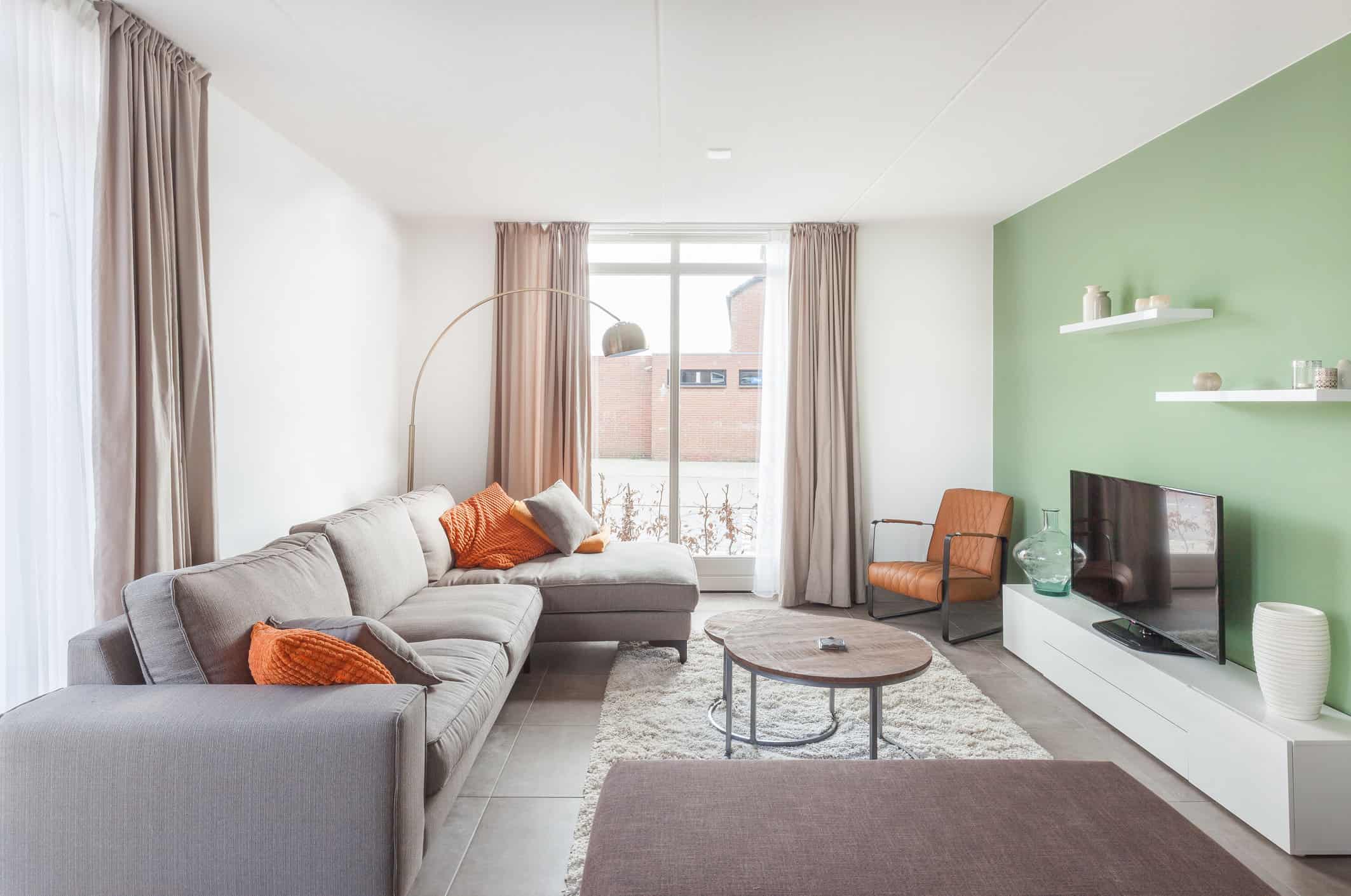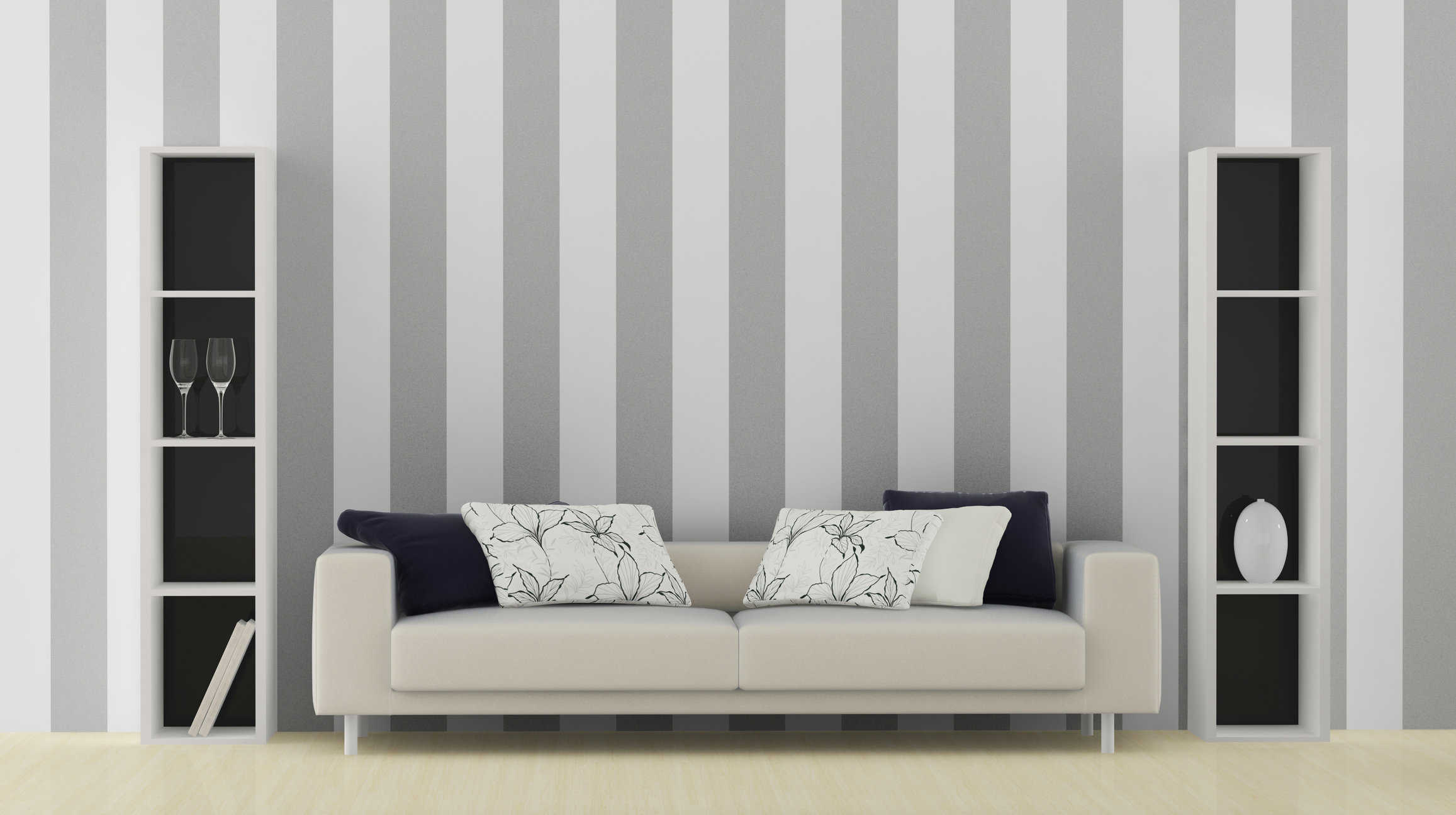One of our challenges as interior house painters is making a small space seem larger. As a DIY painter, you might be facing that challenge, too. The right color choices can turn a cramped room into one that feels spacious and welcoming. In this post, we’ll explore the colors that make a small room look bigger, offering practical tips to open up your space.
Colors That Make a Small Room Look Bigger

Colors and Perception
Color profoundly influences how we perceive and interact with spaces. It’s not just about aesthetics; color can dramatically alter our perception of a room’s size and shape. Lighter colors make spaces feel more open and expansive. They have a unique property of reflecting light, which helps to illuminate and visually “push back” the walls of a room, creating the illusion of more space. This is why hues such as off-white, pale blue, or light gray are often chosen for smaller rooms; they make the area feel airy and less confined.
On the other hand, dark colors absorb light, which can make a room feel smaller and more intimate. Deep shades like navy, forest green, or burgundy, tend to draw in the walls and absorb shadows, creating a cozier and more condensed space. This can be particularly effective in larger rooms that need a sense of warmth and containment.
This phenomenon goes beyond simple optical effects; it taps into our psychological responses to our environment. Light and bright spaces are often seen as more inviting and rejuvenating, while darker spaces can evoke a sense of luxury or comfort.
Moreover, our emotional responses to color can impact how we perceive the space around us. For instance, warmer tones can create a welcoming atmosphere, whereas cooler tones might induce a feeling of calmness and serenity. This psychological interplay between color and perception is a critical element in interior design, allowing us to shape spaces that are not only beautiful but also psychologically harmonious with our needs and emotions.
Ideal Colors for Small Spaces
While many might default to white or beige to create an illusion of space, there are many other colors that make a small room look bigger and more inviting. Each of these colors brings its unique ambiance and can transform a cramped area into a cozy and stylish space. Let’s explore how these colors work their magic and how they can be used to their full potential.
Soft Whites
Soft whites are more than just a basic color; they are a transformative tool in interior design. When applied to walls, these hues act like a mirror for light, bouncing it around the room and making the space feel more open and airy. This reflective quality is particularly beneficial in smaller or darker rooms, where natural light is limited. Soft whites also offer a neutral backdrop, allowing for flexibility in decorating. You can pair them with contrasting textures, like rough wood or soft fabrics, or introduce pops of color through artwork and accessories. This versatility means that soft whites can adapt to any style, from minimalist to eclectic, making them a universally appealing choice for creating a spacious feel.
Light Grays
Light gray is a sophisticated and modern choice that brings a unique dynamic to smaller spaces. It straddles the line between neutrality and depth, providing a subtle backdrop that can make rooms appear more spacious. Unlike stark whites, light gray adds character without overpowering a room. It pairs beautifully with a range of decor styles and colors, from bold and vibrant to soft and muted. Incorporating light gray with bright accessories, such as colorful throw pillows, modern art, or indoor plants, can add a lively contrast and bring a refreshing, contemporary look to the space. Light gray also works well with natural materials, like wood and stone, lending an elegant yet understated ambiance.
Pale Blues
Pale blues are reminiscent of the sky and sea, evoking a sense of openness and tranquility. This color can transform a small, cramped room into a serene escape. It’s particularly effective in areas with ample natural light, where the color can interact with the sunlight to visually expand the space. Pale blues work well with white trim or light wooden furniture, creating a breezy, coastal feel. They also pair nicely with cream or beige for a softer look. In a well-lit room, pale blue can make the walls seem to recede, giving the illusion of more space and creating a peaceful, airy atmosphere.
Soft Greens
Soft greens bring the calming essence of nature indoors, creating a refreshing and serene space. This color is perfect for rooms that lack natural scenery, as it replicates the peacefulness of a lush garden or a quiet forest. Soft green is a versatile shade that pairs well with natural elements like wood, stone, and plants, enhancing its organic feel. It’s a great choice for creating a harmonious and earthy vibe in a room, making it feel more spacious and connected to the outdoors. Soft greens are also known for their soothing qualities, making them ideal for bedrooms or study areas where a calm and focused atmosphere is desired.
A Handy Guide to Colors That Make a Small Room Look Bigger
| Color | Why It Works | How to Use It |
|---|---|---|
| Soft Whites | Soft whites reflect light, enhancing the sense of space. They serve as a blank canvas, making a room feel airy and open. | Combine soft whites with contrasting textures or accent colors to add depth without overwhelming the space. |
| Light Grays | Light gray offers a subtle, modern feel, making it a versatile choice for small spaces. | Pair light gray with bright accessories or plants for a refreshing, contemporary look. |
| Pale Blues | Pale blues evoke feelings of the sky and ocean, expanding the perception of a room’s boundaries. | Use pale blues in well-lit areas to maximize their space-enhancing effect. |
| Soft Greens | Soft greens bring a touch of nature inside, creating a serene, spacious feeling. | Balance soft greens with natural wood tones for a harmonious, earthy vibe. |
Expanding Your Room Visually
The colors and finishes we choose play a crucial role in how we perceive the size of a room. Beyond just picking the right hue, the way we use color and finish can dramatically alter the feeling of space. Let’s explore some effective techniques to visually expand your room.
Contrast and Accents
Introducing contrasting colors for trims and accents is a powerful way to add depth and dimension to a room. By pairing a light wall color with darker trims, or vice versa, you create a visual interplay that can make the walls appear further back. This technique is particularly effective in rooms with high ceilings or larger windows, as it draws the eye upwards or outwards, enhancing the room’s overall size. Contrasting accents can also be used in the form of colorful throw pillows, rugs, or artwork, which add points of interest and break up the monotony of a single color, lending a more dynamic and spacious feel to the room.
Continuity in Color
Creating a sense of continuity by painting walls and moldings the same color can significantly open up a space. This approach minimizes visual interruptions, allowing the eye to move smoothly around the room. By extending the wall color onto the ceiling, you can create an unbroken, expansive feel, as the boundaries between the walls and ceiling blur. This technique is especially useful in rooms with irregular shapes or low ceilings, as it can help to mask these limitations and give the illusion of a more uniform and open space.
Reflective Finishes
Incorporating paints with a slight sheen can enhance the spacious feel of a room by reflecting light. A satin or semi-gloss finish, for instance, can subtly bounce light around the room, making it appear brighter and larger. This effect is most noticeable in well-lit areas, where natural or artificial light can interact with the sheen to enhance the sense of openness. Reflective finishes work particularly well in combination with lighter colors, as they amplify the light-reflecting properties of the hue, further contributing to the perception of a more expansive space.

Additional Tips for Small Rooms
Making a small room look bigger isn’t just about choosing the right paint color. It’s also about how you light the room, decorate it, and select furniture. Each element plays a role in creating the perception of space. Here are some additional tips to make small rooms appear more open and inviting.
Strategic Lighting
Effective lighting can make a world of difference in a small room. Combining natural light with strategic artificial lighting can brighten the space and create a sense of openness. Use layered lighting with a mix of overhead lights, floor lamps, and table lamps to eliminate dark corners and evenly distribute light throughout the room. Consider the color temperature of your bulbs as well; warmer tones can create a cozy atmosphere, while cooler tones mimic natural daylight and help to make the space feel more open and airy.
Decorative Elements
Mirrors are a fantastic tool for making a small space feel larger. When placed strategically, such as opposite a window, they can reflect light and views, effectively doubling the visual space of the room. Minimalistic décor is also key; choosing fewer, but more impactful, decorative elements can prevent a room from feeling cluttered. Consider using wall art, cushions, and rugs that complement the room’s color scheme to add style without overwhelming the space.
Furniture Choices
In small rooms, the size and placement of furniture can significantly impact how spacious the room feels. Opt for pieces that have a smaller footprint and clean lines. Furniture that is lifted off the floor on legs can create a sense of lightness and space. Additionally, multi-functional furniture, such as ottomans with storage or a sofa bed, can be highly beneficial in maximizing utility without sacrificing floor space. Arranging furniture in a way that allows for easy movement around the room can also give an illusion of more space.
Conclusion
Choosing colors that make a small room look bigger is an art and a science. While the right paint can transform your space, remember it’s just part of a larger puzzle. Consider lighting, décor, and furniture as complementary elements. For a professional touch, reaching out to experienced interior painters can ensure a flawless execution of your vision. As you start your next project, keep these tips in mind to create a space that feels as expansive as it is stylish.
Ready to transform your small space? Get expert advice on making your room look bigger and better! Call us now at 908-869-8799 for a free consultation.


